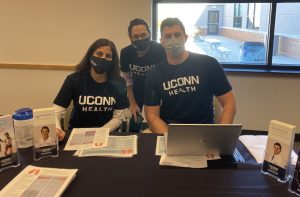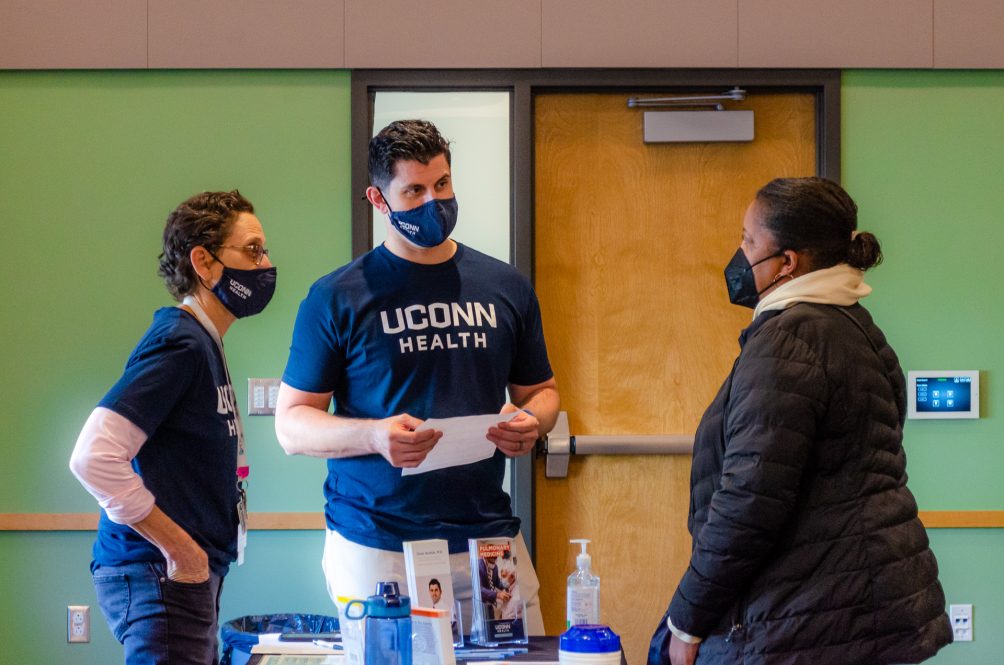Lung cancer is by far the leading cause of cancer death among both men and women, making up almost 25% of all cancer deaths. Each year, more people die of lung cancer than colon, breast, and prostate cancers combined.
On November 16, 2021, UConn Health held a complimentary lung cancer screening event at the Bloomfield Community Center where they connected with about 80 people concerned about their chances for lung cancer.
“Patients who have smoked one pack a day for 20 or more years and are between the ages of 50-80 with no symptoms should be screened,” says Electra Kaloudis director, Lung Cancer Screening Program at UConn Health.

Those who attended the event were able to speak to Kaloudis, Dr. Omar Ibrahim, director, Interventional Pulmonary at UConn Health and Dr. Susan Tannanbaum chief of the Division of Hematology and Oncology in the Department of Medicine and the clinical director of the Carole and Ray Neag Comprehensive Cancer Center at UConn Health,who provided screenings to those eligible.
Patients who needed further assessment were scheduled for an appointment at UConn Health.
“At UConn Health we are helping those in underserved populations where screening is often an afterthought by providing fares for buses and Uber rides,” says Ibrahim. “We want to make sure that access is provided to everyone.”
Early detection is key and when caught early can be treated with surgery. Unfortunately, lung cancer is often detected when patients have symptoms and at that point has grown to a point at which it is not curable, which is why screenings are so important.
Diahann Wilcox, DNP, APRN, Tobacco Treatment Specialist at UConn Health, provided information and resources to help smokers quit.
“There are many free resources to help people quit smoking.” Says Wilcox “A combination of counseling and FDA approved medications or nicotine replacement therapies is often the most successful.”
The CT Quitline is a telephone helpline offered free of charge that provides cessation counseling, quitting information, answers to your questions, and support you need while quitting. The American Lung Association has been helping people quit smoking for over 35 years through Freedom From Smoking®. BecomeAnEX is another option at becomeanex.org.
The American Cancer Society’s Great American Smokeout® is November 18th and they can tell you about the steps you can take to quit smoking and help you find quit-smoking programs, resources, and support that can increase your chances of quitting successfully. The American Heart Association also provides information, finding what works for you is important
To quit smoking UConn Health recommends these five steps:
- Pick a quit date – Consider choosing the national Great American Smoke Out on Nov. 18 as your quit day.
- Prepare to quit – Think about the reasons why you want to quit and write them down. Post the reasons where you will see them every day.
- Know your resources – Talk to your provider about different quitting aids to consider, including over-the-counter nicotine replacements. Also, explore and join a local smoking cessation program. The Food and Drug Administration has not found any e-cigarette to be safe and effective in helping smokers quit.
- Build support– Let your family, friends, and co-workers know you are trying to quit so they can help encourage you.
- Anticipate challenges – Less than 5 percent of smokers are able to quit cold turkey. If you are having trouble, start using a smoker tracker to record each cigarette you smoke and to better understand your smoking triggers so that you can better prepare for them. Also, plan for how to address the people, situations, and events that may trigger your urge to smoke.
It’s never too late to quit, no matter how old you are or how long you have smoked.
How your body recovers after quitting:
- 20 minutes- your heart rate and blood pressure drop.
- 12 hours- the carbon monoxide level in your blood drops to normal
- 2 weeks to 3 months- your circulation improves, and your lung function increases
- 1-9 months – coughing and shortness of breath decrease; cilia start to regain normal function in the lungs, increasing the ability to handle mucus, clean the lungs and reduce the risk of infection
- 1 year- the excess risk of coronary heart disease is half that of someone who continues to smoke. Your heart attack risk drops dramatically
- 5 years- The risk of cancer of the mouth, throat, and esophagus, and bladder are cut in half. Cervical cancer risk falls to that of a non-smoker. Stroke risk can fall to that of a non-smoker after 2-5 years.
- 10 years – the risk of dying from lung cancer is about half that of a person who is still smoking. The risk of cancer of the larynx (voice box) and pancreas decreases.
- 15 years- the risk of coronary heart disease is that of a non-smoker. (American Cancer Society)
For more information on lung cancer screening, call UConn Health at 844-777-LUNG to discuss your health history and answer a few questions. A nurse navigator will call you back to discuss your eligibility for the screening test.



